Colorectal cancer epidemiology (1990-2050): lessons from the Australasian experience
- PMID: 40745565
- PMCID: PMC12312429
- DOI: 10.1186/s12967-025-06630-z
Colorectal cancer epidemiology (1990-2050): lessons from the Australasian experience
Abstract
Background: CRC is regarded as a worldwide health issue, exhibiting considerable geographic differences. The current research examines the global epidemiology of CRC (1990-2021) and forecasts trends until 2050, focusing specifically on Australasia.
Methods: We performed an extensive analysis using data from the Global Burden of Disease 2021 study to calculate age-standardized incidence and mortality rates (ASIR/ASMR) for CRC from 1990 to 2021. Analyses were divided by sex, age, geographic area, and SDI. Temporal trends were evaluated by utilizing EAPC. We assessed the impact linked to significant modifiable risk factors such as dietary risks, elevated body mass index, alcohol consumption, smoking, and lack of physical activity using comparative risk evaluation techniques. To forecast CRC mortality until 2050, we utilized a Bayesian Age-Period-Cohort (BAPC) model that includes demographic and temporal factors.
Results: Regions with high SDI exhibit the highest incidence of CRC but show decreasing trends, whereas regions with middle SDI are experiencing increasing burdens. Australasia, despite its historically high rates, accomplished notable reductions in mortality (-1.95% per year), positioning itself alongside Austria and Germany as frontrunners in CRC management. The rate of CRC occurrence is believed to be greater in males than in females. Dietary elements are the primary alterable risk factor worldwide, particularly in affluent areas. Forecasts and future estimates indicate additional declines in mortality rates in high-income areas, while transitioning economies face rising burdens.
Conclusion: The burden of CRC is moving towards developing areas. Australasia showcases effective cancer management via screening and treatment, offering essential insights for global policies and strategies addressing changeable risks.
Keywords: Australasia; Cancer epidemiology; Colorectal cancer; Global burden; Sociodemographic disparities.
© 2025. The Author(s).
Conflict of interest statement
Declarations. Ethics approval and consent to participate: Not applicable. Consent for publication: Not applicable. Competing interests: The authors declare no conflict of interest.
Figures







Similar articles
-
Global burden trends and future predictions of ischemic heart disease attributable to air pollution in people aged 60 years and older, 1990-2021.Front Public Health. 2025 Jul 4;13:1598092. doi: 10.3389/fpubh.2025.1598092. eCollection 2025. Front Public Health. 2025. PMID: 40687134 Free PMC article.
-
Burden of knee osteoarthritis in China and globally: 1990-2045.BMC Musculoskelet Disord. 2025 Jul 1;26(1):582. doi: 10.1186/s12891-025-08858-8. BMC Musculoskelet Disord. 2025. PMID: 40598022 Free PMC article.
-
Epidemiological trends and forecasts in stroke at global, regional and national levels.J Stroke Cerebrovasc Dis. 2025 Aug;34(8):108347. doi: 10.1016/j.jstrokecerebrovasdis.2025.108347. Epub 2025 May 15. J Stroke Cerebrovasc Dis. 2025. PMID: 40381865
-
Aspirin for prophylactic use in the primary prevention of cardiovascular disease and cancer: a systematic review and overview of reviews.Health Technol Assess. 2013 Sep;17(43):1-253. doi: 10.3310/hta17430. Health Technol Assess. 2013. PMID: 24074752 Free PMC article.
-
Chemoprevention of colorectal cancer: systematic review and economic evaluation.Health Technol Assess. 2010 Jun;14(32):1-206. doi: 10.3310/hta14320. Health Technol Assess. 2010. PMID: 20594533
References
-
- Zheng R, et al. The epidemiology of colorectal cancer in China. Global Health J. 2018;2(3):8–20.
-
- Morgan E, et al. Global burden of colorectal cancer in 2020 and 2040: incidence and mortality estimates from GLOBOCAN. Gut. 2023;72(2):338–44. - PubMed
MeSH terms
LinkOut - more resources
Full Text Sources
Medical

